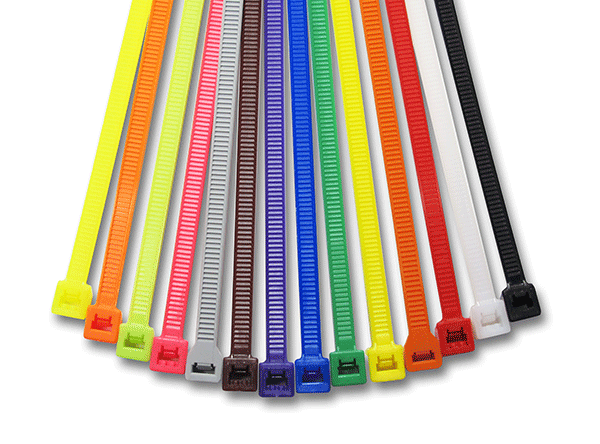You can frequently find racks, frames or panels in the cabling system. They are necessary components for cable management. However, sometimes you may easily forget about a small but helpful tool for cable management – that is cable tie. People’s first impression about cable tie is always a self-locking and colorful plastic strip. They think cables ties are pretty much the same. Seldom have they considered about whether they are choosing the right or not. In fact, cables ties have many different distinctions in construction, material, color, size and some special features. So do you want to know if your selection is right? Don’t worry. The following parts will give the explanation.

Cable ties have to be able to meet the most varied demands these days as they are used in the widest range of operations – from the simple bundling of cables with cable ties to the absolutely specific use of cable ties under extreme conditions. Thus, many factors are taken into consideration during the design of cable ties.
Cable ties can be classified as either one-piece or two-piece construction. One-piece cable ties typically have a plastic locking device molded into the head of the tie. The locking device ratchets the notched strap to tighten and lock. This design has a lower cost of manufacturing and is used for general applications around home or office. Compared to one-piece cable ties, two-piece cable ties are with higher performance. They consist of a stainless-steel locking device embedded into the head of the tie, and a smooth locking strap. This design offers high tensile strength, and resistance to mechanical and environmental stress for applications that require greater performance than what a general cable tie offers. In addition, the smooth, infinitely adjustable strap also allows for the exact bundled tightness. The head of the two-piece cable tie engages the strap when installed, and permanently locks in place. With a lower profile and smoother cross-section, the uniform cross-section distributes stress across the strap more evenly than with one-piece cable ties. Thus, the two-piece cable ties are more resistant to brittleness and breakage in harsh environments, particularly appropriate for harsh conditions, such as ultraviolet exposure, extreme temperature, and exposure to moisture or chemicals, as well as for applications where retrofitting is not an option.
The material design of different cable ties also needs to consider for different applications, such as occurring indoors or outdoors; the environment’s temperature range; the presence of moisture, chemicals and radiation; flammability issues; and cost. Cable ties are available in a wide range of materials, each with its own specific properties. Among them, the most common type is nylon cable ties. Nylon ties can offer good resistance to weather and ultraviolet rays in lower temperatures. In addition, for applications in harsher environments that require extra durability in the face of heat, chemicals and other corrosive elements, there are stainless-steel cable ties.
The most commonly used cable ties are white and black. But colorful cable ties are also popular with users. These cable ties with rainbow colors are very useful when you are trying to color-code your cables, or just want to match the ties to your equipment. Moreover, you can use different cable ties to mark different cables bunch which is convenient for cable management.
When using cable ties, you should also consider the size and shape. First, be sure to measure the diameter of the cable bundle you’ll be tying and decide the length. In general, to buy cable ties with a little longer length is better. Because no one wants to find out at the last minute that the cable ties are too short to use. In addition to length, width or shape are also important considerations to choose optimal cable ties for your cable bunch.
Though the standard-design cable ties can meet most of our requirements, sometimes, we still need something special for special applications. For instance, most cable ties lock permanently, but sometimes, we would prefer to looking for a solution that cable ties can be undone without actual cutting. Then, releasable cable ties have been launched in the market. In a releasable cable tie, the built-in locking tab can actually be disengaged, allowing the tail end of the tie to be pulled free from the head. Releasable cable ties tend to cost a little more than the standard type, but they save money and are more eco-friendly in the long run because you can reuse them over and over instead of just throwing them away. Additionally, for different special applications, there are mounted head cable ties, marker ties, etc.
It is very unprofessional to use random cable ties for your cable management. Knowing the secrets about cable ties can lead you to choose the matching cable ties for your applications. This will greatly reduce the unnecessary problems during actual practice. Actually, no matter cable ties or other assembles, each component of cabling system should not be underestimated. The right selection will greatly increase the efficiency of a cabling system.
